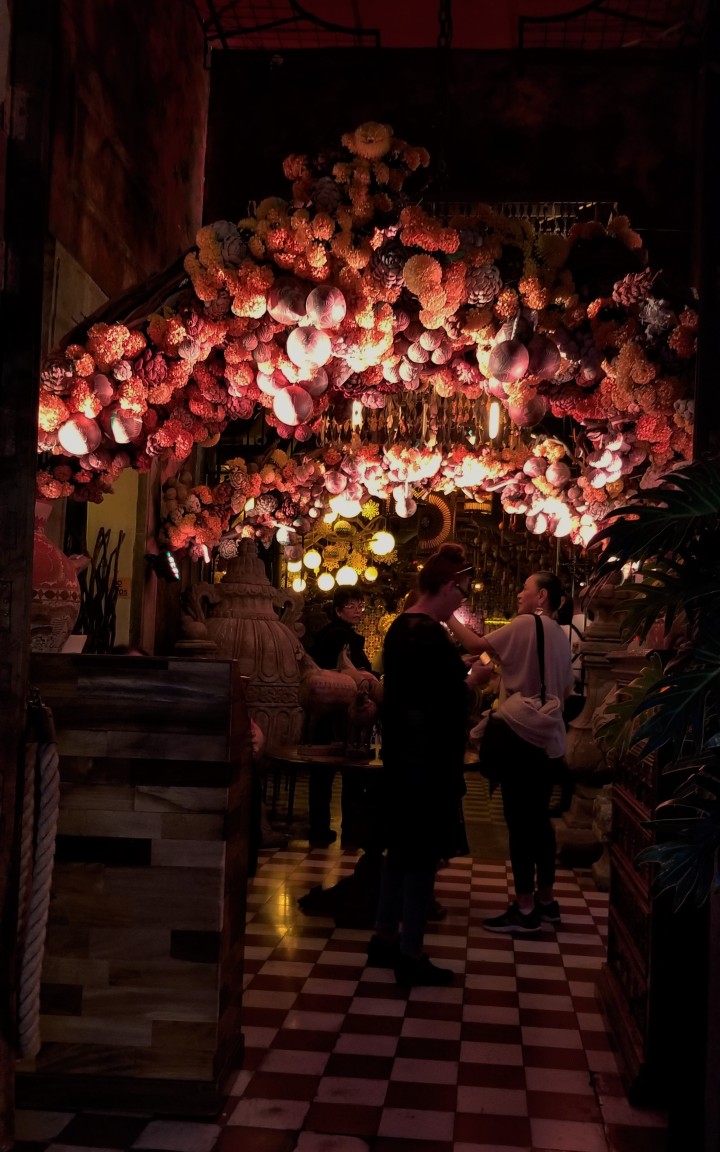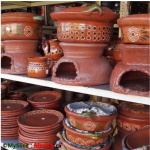
Text above: “Tlaquepaque of my heart”
As I mentioned in previous posts, I recently had the chance to visit the beautiful city of Guadalajara, in the Mexican state of Jalisco, where my newlywed niece and nephew in-law are hoping to settle as a family. Even though I was there just for a weekend with very short notice, they found room in their super busy schedules to get together and visit some of the most characteristic and unique spots of the metropolitan area. Guadalajara has a population close to one and a half million but, if the surrounding municipalities are included, this figure goes up to almost five million people. One of these municipalities is Tlaquepaque; in spite of being a true city, with a population close to 600 000 (in 2010), it was granted the title of “Pueblo Mágico” (“Magic Town”) in 2018. “Pueblo mágico” is a denomination granted by the Mexican Tourism Secretariat to recognize locations around the country with outstanding or unique features regarding their history, natural beauty, architecture, gastronomy or cultural heritage. The program started in 2001, and currently there are 121 magic towns. The state of Jalisco has eight: Lagos de Moreno, Mascota, Mazamitla, San Sebastián del Oeste, Talpa de Allende, Tapalpa, Tequila, and Tlaquepaque.
Tlaquepaque’s magic begins with the earth itself; its natural soil composition includes strata with high content of pumice stone and clay. Many historians attribute this region’s name to this fact and its long lived tradition of pottery, from the Nahuatl form Tlacapan (tlacah – humans or men, tequipanoa – to work and tlālpantli – soil, clay): “men who work clay”; other interpretations include Tlalipac (tlālpantli – soil, tepec – hill): “on clay hills”, or a compound word from tlachia – to look, to see, and paqui – to be happy: “cheerful views.”
In pre-Hispanic times, it was inhabited by the Tonalteca (Tlaquepaque and other towns formed an independent kingdom with Tonalá) and, at the arrival of the Spaniards in 1529, the Tecuexes and Cocas (who ran away to secluded areas amongst the hills.) In 1530, a vicious campaign to quickly conquer the region by Nuño Beltrán de Guzmán, left the area of current Jalisco with a decimated and enslaved native population. In 1548, It was renamed San Pedro Tlaquepaque (after St. Peter) and the construction of the Parish Church of St. Peter Apostle began in 1670, finally completed in 1813:

In November of 1810, father Miguel Hidalgo y Costilla, a Catholic priest who had called the peoples of Mexico to fight for Independence in September of that year, stopped in Tlaquepaque with his army, on the way to take the city of Guadalajara. At the end of the cruel war that lasted more than a decade, “El Plan de Iguala”, the declaration of Independence, was officially signed in San Pedro Tlaquepaque on June 13, 1821, making this magic town the cradle of Mexico as a nation. The sculpture “The Cry Continues” by artist Camilo Ramírez, captures those pivotal moments in History, with a female figure next to Hidalgo, representing our mother land, and followers in clothing from the revolution war era (1910s) as an allegory of a continued fight for justice and freedom over time:

Mariachi music originated in the state of Jalisco so, in every corner of the state, including Tlaquepaque, mariachi bands are expected to have a presence. While walking on Andador Independencia (a pedestrian-only corridor), we encountered not only a mariachi band, but an all-female group, merrily singing:

The violin section started performing with skill:

And the trumpets were strategically located in a balcony above the crowd:

Along the corridor, there were many stores with Arts and Crafts:


There was also a large selection of restaurants, and other establishments with sweet offerings and snacks, such as old-fashioned sorbets called nieves de garrafa:

“Garrafa” is the name of the metal containers used to prepare the icy treats, keeping them well frozen. Some of the containers may be seen in the background of the photo below, featuring my nieve de elote (sweet corn sorbet):

At the end of the corridor, we encountered many street vendors. One of them also with old-fashioned frozen treats; these were ice cream bars moulded in metal cones, as the ones seen next to the barrel:

The next stand really sent me back to my youth in Mexico City, where I would seek carts offering boiled or roasted corn on the cob, and another favourite, “esquites”, corn (maize) kernels, boiled with herbs and flavourings:

“El Parián” is a busy plaza with mariachi bands and lots of food, set as a kiosk surrounded by 18 restaurants with local specialties. Tlaquepaque is known for its clay work, so it is not surprising that one of the most popular drinks is “La cazuela voladora” (“The Flying Clay Pot”). At “Paco’s” restaurant, one of their specialties is a giant version of it; imagine a wide clay pot, masterfully crafted to 2 ft. (60 cm) in diameter:

Now fill that with a mix of ice, citrus flavours, tequila and a good measure of carbonated water, to aerate the drink and make it extra bubbly, as illustrated below on a poster outside the restaurant:

This refreshing concoction is meant to be shared by several people, using long straws; it was exciting to see, but also a little scary, and I could not imagine ever being able to drink one of this.
On our way back along the same corridor, my niece and nephew in-law treated us to beverages and snacks at “Casa Luna” (Calle Independencia 211, Centro, 45500 San Pedro Tlaquepaque) a lovely restaurant and bar, featuring an eclectic décor all around their patio:
Their menu was also an interesting mix of traditional items and fusion dishes. We shared a tasty spread of the house totopos (tortilla chips) and salsas:

We also had a queso fundido con hongos (melted mix of three cheeses with mushrooms) served in a molcajete (stone mortar), and a unique platter of molotes de cochinita (fried parcels filled with Yucatan style pork, on a tomato based sauce and a side of pickled onions):

My niece ordered an individual serving of “cazuela voladora” (now, this I could handle, I think):

It was such a pleasant and gratifying experience, and I still feel so thankful for the lovely couple’s attentions and especially the time spent together.
By the time we finished our meal and wrapped up our conversation, it was dark outside, and the lighting in the restaurant’s reception area gave the room a truly magical look:

And just for the perfect ending, on our way out we saw a friendly “organillero” turning the handle of his pipe organ music box:

I was almost expecting to see a little zoo monkey collecting tips in a tin, like in the olden days, but I was glad that did not happen!
In my next posts, back in Canada, I will share my take on the “cazuela voladora” and “esquites.”














What an unbelievable post. Thank you for sharing. I didn’t know that Mariachi music – which I adore- originated in the state of Jalisco.
LikeLiked by 1 person
Thank you, I am glad you liked it!
LikeLiked by 1 person
I truly did
xoxo
LikeLiked by 1 person
Tlaquepaque looks like a delightful place! Historic, full of wonderful music and food. Looks like an area I’d like to visit! Gracias for the tour.
LikeLike
De nada!
LikeLiked by 1 person
Tantas gracias. I adore traveling to pueblos mágicos with you!!
LikeLiked by 1 person
Gracias, Victoria!
LikeLike
It sounds like a fantastic and colorful place to visit, and the food looks delicious!
LikeLike
Thank you, Cara!
LikeLike
It is indeed magic, Irene. The pottery and tiles are amazing. Also, no resisting those delicious looking ice confections. It must feel like a festival every day.
LikeLike
It truly felt like there was magic there, Tracy, thank you for your comment!
LikeLiked by 1 person
Welcome, Irene.
LikeLiked by 1 person
What a wonderful sharing of your wonderful time with loved ones in Jalisco. I loved every step on your path.
LikeLiked by 1 person
Excellent reporting!
LikeLike
Thank you!
LikeLike